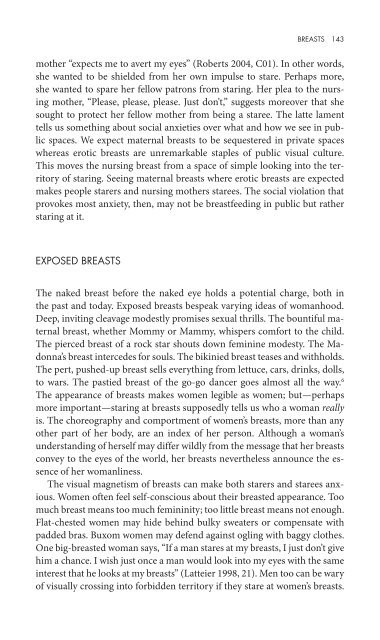Staring how we look sobre la mirada.pdf - artecolonial
Staring how we look sobre la mirada.pdf - artecolonial
Staring how we look sobre la mirada.pdf - artecolonial
Create successful ePaper yourself
Turn your PDF publications into a flip-book with our unique Google optimized e-Paper software.
REGULATING OUR LOOKS 67<br />
subjects to disp<strong>la</strong>y their status and position through e<strong>la</strong>borately legible costumes<br />
and uniforms that announced who they <strong>we</strong>re to everyone who <strong>look</strong>ed<br />
at them. Citizens of democracy, in contrast, supposedly had the opportunity<br />
to change their status at any time. Appearance needed to reflect this ideal of<br />
equality. To realize this promised social fluidity, people’s appearances should<br />
not lock them into a particu<strong>la</strong>r status but should accommodate aspirations<br />
toward social mobility. Nevertheless, a person’s social position at a given moment<br />
needed to be proc<strong>la</strong>imed. What you <strong>look</strong>ed like, then, should suggest<br />
who you <strong>we</strong>re to your anonymous visual interlocutors but not reveal enough<br />
information to trap you into any particu<strong>la</strong>r fixed identity. Aspiring Americans<br />
<strong>we</strong>re on the move—socially, economically, and geographically. They<br />
disp<strong>la</strong>yed that mobility in the appearance of being busily headed somewhere<br />
else. To be pinned down by a stare made them wiggle with anxiety.<br />
An illegible appearance gives Americans room to travel; inconspicuous<br />
<strong>look</strong>s let you make yourself up. Nonetheless, social interaction also requires<br />
that <strong>we</strong> be able to recognize one another. The confidence man and the humbug,<br />
for example, must be distinguishable from the genuine thing. 4 Spectacles<br />
of hierarchical status such as royal crowns and robes, heraldry, coronations,<br />
and e<strong>la</strong>borate insignia encourage obeisant staring. In contrast, middle-c<strong>la</strong>ss<br />
status repudiates f<strong>la</strong>mboyance, demanding instead the stealth signification<br />
of gray f<strong>la</strong>nnel suits and briefcases that now mark undifferentiated proper<br />
democratic attire. So while accruing middle-c<strong>la</strong>ss status benefited Americans,<br />
conspicuously disp<strong>la</strong>ying status was considered inappropriate. The<br />
dandy, for instance, who attracted attention with expressive costuming and<br />
behavior, was a residually aristocratic figure especially targeted for social approbation<br />
(Kasson 1990, 118–28). 5 The egalitarian ethic of appearance contained<br />
contradictions that staring troubled. Middle-c<strong>la</strong>ss men <strong>we</strong>re doers not<br />
<strong>look</strong>ers. You wanted to appear comfortably middle-c<strong>la</strong>ss without f<strong>la</strong>unting<br />
it. 6 Even aspirations toward middle-c<strong>la</strong>ss status needed to be muted so as not<br />
to disclose any vulnerability. The trick was knowing <strong>how</strong> to dec<strong>la</strong>re yourself<br />
without revealing too much of yourself. The strict visual conduct detailed<br />
in the popu<strong>la</strong>r etiquette guides suggests that staring led to Edenic forbidden<br />
knowledge—too dangerous for everybody’s own good.<br />
GENTLEMANLY LOOKING<br />
Gentlemen do not stare. As unmoved movers, middle-c<strong>la</strong>ss men should<br />
strive to be self-possessed agents of their own futures. The vulnerable openness<br />
or intrusive presumption of staring vio<strong>la</strong>tes a hands-off ethic among<br />
citizens uneasily scrambling to appear both equal and aspiring at the same


